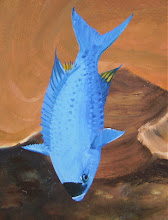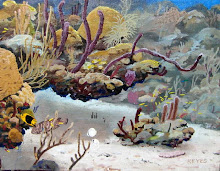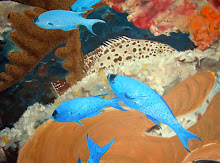A big, old Conch. Odd to find him up here in the rocky shallows. They usually stay out in the big sandy area in twenty to thirty feet depth- seven to ten meters.
A Sand Tilefish. They are usually out in the sand, and on the slope. They dig burrows, and 'dive' into them when you approach.
Another conch wandering around. You can just barely see his snout, probiscus, that he shuffles around looking for tasty detritus to munch. My taste buds are a little different.
And yet another. I guess they got together and decided they didn't like something about being out in the sand.
A Squirrelfish keeping a close eye on me, as the Blue Tang cruises by..
See ya, Tang! Poor old Mr. Squirrel looks so miserable, but it's just how his bones are put together. I've always thought it's unfortunate for fish that the most efficient structure for their mouth for food gathering gives them an unhappy, grouchy expression. They need a Dolphin's smile.
Almost looks like West Texas, or New Mexico.
Ha, another Squirrelfish, over sand. He's changed to white to be less visible, but his eyes sort of give him away. No, I don't want to eat you!OK, I need to go plant some Bougainvillea vines that I've rooted. Digging in the dirt, insted of diving, hey? Thanks for stopping by!
.









.jpg)



.jpg)
.jpg)
.jpg)
.jpg)
.jpg)
.jpg)
.jpg)
.jpg)
.jpg)
.jpg)
.jpg)
I just found your site yesterday and love it!! You are blessed to live the life you do and thanks for taking us along each day, too!!
ReplyDeleteI'm happy that I can share a bit of diving with you. I certainly don't take the same sort of photos most underwater photogs do.
ReplyDeleteAnd I live in a state of gratitude. I know that I am blessed.
Thank you for your kind words.
Melissa, how long can you stay underwater with the oxygen tanks? Obviously I've never scuba dived, so I have another stupid question.
ReplyDeleteHow deep can a person go (who can hold his breath for about a minute) without the oxygen tanks?
There are no stupid questions, OK? You breathe air using tanks, scuba, just plain air like you're breathing right now.
ReplyDeleteThe length of a dive depends on depth, in general. You use up your supply of air more quickly the deeper you go. Also, there are limits imposed by the increasing pressure the deeper you go. I won't go into detail about that here.
The recreational, safe limits are about fifty feet depth for fifty minutes. The deepest you can safely go is 130 feet, but you can stay only about seven? minutes.
If you stay in twenty feet of depth, you can use up your whole tank of air-- the longest dive I've done was 214 minutes, in twenty feet and shallower.
It's called 'free diving' when you just go, breath holding, no scuba tanks. Umm, you might not believe me, but the World record free dive record for a man is something like 214 meters, 702 feet, and a woman 160 meters, 524 feet. Obviously these folks are a little different than you and me!
Swimming along and diving down to look at things is called snorkeling. I'm not very good at free diving, I pretty much stay on the surface when I'm snorkelling.
There are schools for free diving that guarantee 100 feet by the end of a week's training. That's really deep! Most snorkelers just go to twenty feet or so.
Scuba diving is safe, but you must have training, there's a lot to learn. It's not difficult at all in warm tropical places like the Caribbean.